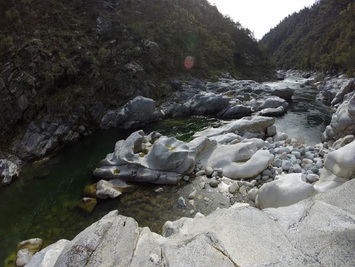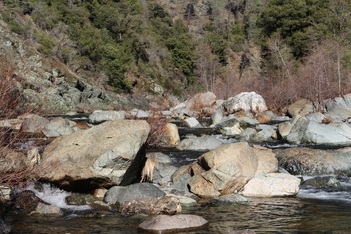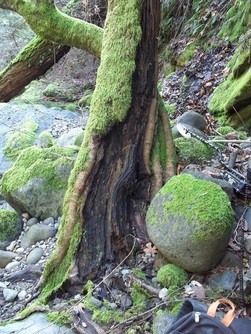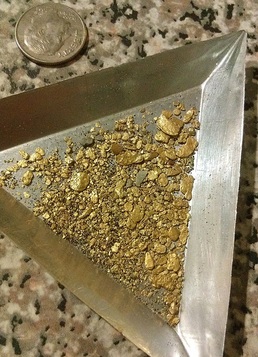|
|
|
How to find gold
Finding Gold - Getting Started.
Here are a few of the basics to help you get started.
Do your research.
You don't want to waste a lot of time looking in an area that has no gold. It's hard to find gold in a river that doesn't have any gold. During the winter is an excellent time to do your research. It is one of the most productive things you can do. When looking for a place to prospect you want to look where gold has been found before. If you spend all your time trying to find a new strike you won't find much gold. The old timers did an excellent job of scouring the countryside.
There are many ways to do this research. The Internet is becoming a great source. When researching try to locate a library in the general area you want to prospect. The library will have some excellent resources on, old newspapers, historical publications, old maps, mining reports, and tax records just to name a few. The county recorder is a great place to see what has been claimed and for how long. One of the best things about doing the research is, you get to know the history of the area. The more history you know the more gold you'll find. When you locate a potential area you need to make sure it is open for prospecting. If it's private property or has been claimed, you will save yourself a lot of trouble by getting permission from the owner.
Ok, you've done the research. You've found a potential area, you've got your "gear" and you're now standing on the bank of the river - now what? One of the most basic skills required to recover gold with a pan is "crevicing". Gold being the densest thing in the river, it will end up as low as it possibly can get, and that is the bottom of a crack in the bedrock. Cleaning out these cracks is called crevicing.
There are plenty of other web sites that will talk about the dynamics of the river, pacer geology and such - but it all comes down to, gold is dense. It's very hard to move, and when it finds a low place to get out of the flow of the water, it stays there . Gold only moves when the river is in its flood stage. It takes unbelievable power to move the boulders and gravel to uncover the gold and make it move. Any place in the stream where the power of the water is diminished the gold will drop out. That could be behind a large bedrock outcropping, where the river widens or makes a sharp bend, or where it can drop into a crevice.
There is a lot that comes into play when looking for a potential area to start panning. One of the first things I look at is the general outlay of the river. Where does it get wide? Where does it narrow up? Are there any sharp bends? Is there any exposed bedrock? What type of bedrock, the color of the gravel, the hardness of the rocks, and the placement of the vegetation all play a role in where to look.
Here are a few of the basics to help you get started.
Do your research.
You don't want to waste a lot of time looking in an area that has no gold. It's hard to find gold in a river that doesn't have any gold. During the winter is an excellent time to do your research. It is one of the most productive things you can do. When looking for a place to prospect you want to look where gold has been found before. If you spend all your time trying to find a new strike you won't find much gold. The old timers did an excellent job of scouring the countryside.
There are many ways to do this research. The Internet is becoming a great source. When researching try to locate a library in the general area you want to prospect. The library will have some excellent resources on, old newspapers, historical publications, old maps, mining reports, and tax records just to name a few. The county recorder is a great place to see what has been claimed and for how long. One of the best things about doing the research is, you get to know the history of the area. The more history you know the more gold you'll find. When you locate a potential area you need to make sure it is open for prospecting. If it's private property or has been claimed, you will save yourself a lot of trouble by getting permission from the owner.
Ok, you've done the research. You've found a potential area, you've got your "gear" and you're now standing on the bank of the river - now what? One of the most basic skills required to recover gold with a pan is "crevicing". Gold being the densest thing in the river, it will end up as low as it possibly can get, and that is the bottom of a crack in the bedrock. Cleaning out these cracks is called crevicing.
There are plenty of other web sites that will talk about the dynamics of the river, pacer geology and such - but it all comes down to, gold is dense. It's very hard to move, and when it finds a low place to get out of the flow of the water, it stays there . Gold only moves when the river is in its flood stage. It takes unbelievable power to move the boulders and gravel to uncover the gold and make it move. Any place in the stream where the power of the water is diminished the gold will drop out. That could be behind a large bedrock outcropping, where the river widens or makes a sharp bend, or where it can drop into a crevice.
There is a lot that comes into play when looking for a potential area to start panning. One of the first things I look at is the general outlay of the river. Where does it get wide? Where does it narrow up? Are there any sharp bends? Is there any exposed bedrock? What type of bedrock, the color of the gravel, the hardness of the rocks, and the placement of the vegetation all play a role in where to look.
 Granite bedrock, You can easily see the erosion
Granite bedrock, You can easily see the erosion
Bedrock
When looking at the bedrock, what type is very important. The harder the bedrock, the slower it erodes. For example a granite bedrock is very soft, it erodes quickly and that doesn't allow enough time for the gold to build up. On the other hand a serpentine is much harder and has a lot of fissures in it. That is a place for the gold to drop out. The fact it erodes slower allows more time for the gold to build up. A shale bedrock has all kinds of crevices in it and erodes quickly, you can find gold In it but you have to break open a lot of bedrock to find the small pieces scattered about.
When looking at the bedrock, what type is very important. The harder the bedrock, the slower it erodes. For example a granite bedrock is very soft, it erodes quickly and that doesn't allow enough time for the gold to build up. On the other hand a serpentine is much harder and has a lot of fissures in it. That is a place for the gold to drop out. The fact it erodes slower allows more time for the gold to build up. A shale bedrock has all kinds of crevices in it and erodes quickly, you can find gold In it but you have to break open a lot of bedrock to find the small pieces scattered about.
 A typical gravel lay
A typical gravel lay
Gravel
The color of the gravel is very important. When you look closely at the gravel you'll notice some rocks are
shiner than others. That is because they are very hard. A hard rock is much denser and heavier. When compare to the softer and lighter rock, they erode much slower. As a result they end up polished. These rocks tend to be darker in color. When you learn to look for it, you will find that they accumulates in definite areas along the river. These areas are what we call heavy gravel. When these dense heavy rocks drop, the gold usually drops with them. What I look for when crevicing, is any exposed bedrock in or along a straight line between these heavy gravel spots.
The color of the gravel is very important. When you look closely at the gravel you'll notice some rocks are
shiner than others. That is because they are very hard. A hard rock is much denser and heavier. When compare to the softer and lighter rock, they erode much slower. As a result they end up polished. These rocks tend to be darker in color. When you learn to look for it, you will find that they accumulates in definite areas along the river. These areas are what we call heavy gravel. When these dense heavy rocks drop, the gold usually drops with them. What I look for when crevicing, is any exposed bedrock in or along a straight line between these heavy gravel spots.
 Large rocks around an old beat up tree can be a good place to pan.
Large rocks around an old beat up tree can be a good place to pan.
Vegetation
The vegetation in the river is another good indicator of the river's dynamics. When you look at the vegetation only consider what is growing below the high water mark. A lot of small trees and large brush In the river channel, indicates that it has been many years since there had been water high enough to move the gold. I look for large trees ( 12" or larger) that are in the riverbed. They will tell you a couple of things. If the tree is bent and all beat up with old wounds that is an indication of water and debris hitting It during flood stage. You know the flow is diminished in this area otherwise there would be no trees. Look to the riverside and upstream for the nearest bedrock, it should be holding gold. If the tree doesn't have any wounds that tells you it's in a backflow area (has no current, or dead water) and there will be no gold in that area.
The vegetation in the river is another good indicator of the river's dynamics. When you look at the vegetation only consider what is growing below the high water mark. A lot of small trees and large brush In the river channel, indicates that it has been many years since there had been water high enough to move the gold. I look for large trees ( 12" or larger) that are in the riverbed. They will tell you a couple of things. If the tree is bent and all beat up with old wounds that is an indication of water and debris hitting It during flood stage. You know the flow is diminished in this area otherwise there would be no trees. Look to the riverside and upstream for the nearest bedrock, it should be holding gold. If the tree doesn't have any wounds that tells you it's in a backflow area (has no current, or dead water) and there will be no gold in that area.
In my next installment we will talk about the tools you need, And how you open and work a crevice. I am hoping that later this spring to be able to post a video. Trying to explain color and texture is difficult. It is much easier to show you, then try to explain it. So stayed tuned for our next adventure, we will keep you up to date with our most current information. You can always check our website, YouTube, or Facebook for the latest information. stay tuned and join me on our next adventure.
|
|
|
